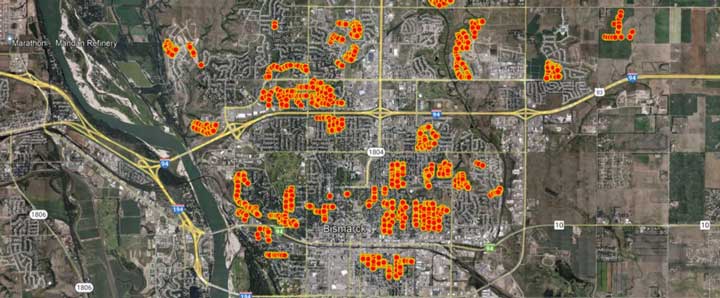GIS & Garbage Technology for Decision Making
May 4, 2022 by Jennefer Klennert
The Public Works Service Operations Division for Bismarck, North Dakota, provides garbage collection services to residential customers in the city – it’s a “take all” approach. To guide its future management approach for garbage collection, the city reached out to our solid waste team at HDR to conduct a study evaluating its collection program. We benchmarked the city against similar communities, performed a sensitivity analysis of potential changes to collection services, and made recommendations for modifications to the collection utility. A lot of our data analysis was streamlined using ArcGIS.

Initially, we worked to identify potential utility modifications to increase collection efficiency and identify a planning tool for the future expansion of the residential collection system. Utility modifications were presented to the city and community members at public input forums. Based on the input, the city decided to modify its collection schedule from five days per week to four, gaining efficiency and cost savings.

The city also wanted to analyze its solid waste collection system specific to its dumpster collection service. Our HDR team assisted the city with an audit of its existing dumpster collection service and subsequent analysis to determine potential modifications to the system that would increase collection efficiency, help with future truck purchasing and increase safety.
Each step helped the city identify opportunities to gain efficiency and refine the program from its former approach that allowed extra garbage to be bagged, boxed, or otherwise contained and placed near the cart for collection.
Surveying via Mobile App & Field Observations
Documentation of each surveyed location for this study was done with a combination of field observations and in a mobile app called ArcGIS Survey123. Results of the surveys were analyzed both separately and together. 5,018 locations were surveyed during two survey events, which consisted of 4,633 curbside locations and 379 alley locations.
Key findings from the data collected included:
- Most trash inside carts was bagged
- Approximately 25% of residents had some additional space to fill their carts or cans (25-75% full) rather than placing items on the ground for collection crews to pick up
- Cardboard and yard waste accounted for 39% (August) and 55% (October) of the total amount of items set outside of the cart
- Most alleys appeared to be large enough to service the alleys with automated cart collection

Survey says a Streamlined Collection Approach
The city found that 86% of residents are following collection guidelines. To manage the collection program even more effectively, our HDR team made a series of recommendations:
- Education is important and may positively impact program results - communicating with residents on how services are best provided may help reduce the number of items set outside of carts
- Collecting yard waste seasonally may reduce the ongoing presence of bags outside carts
- Additional capacity for recycling could be offered, including “take all” recycling or additional carts
- Asking residents to “fit it in” through education campaigns could help reduce the strain on additional collections







Leave a comment